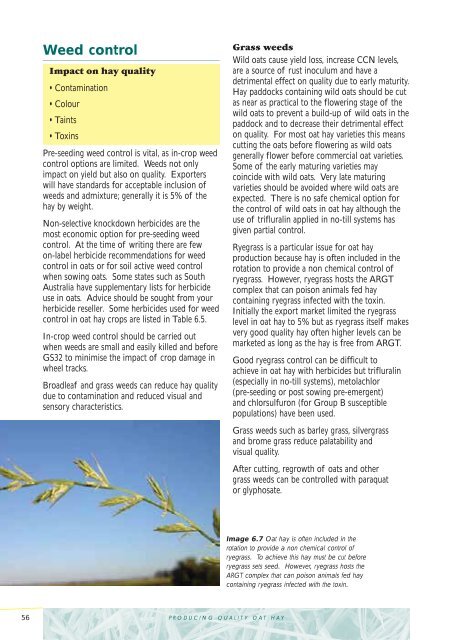You also want an ePaper? Increase the reach of your titles
YUMPU automatically turns print PDFs into web optimized ePapers that Google loves.
Weed control<br />
Impact on hay quality<br />
• Contamination<br />
• Colour<br />
• Taints<br />
• Toxins<br />
Pre-seeding weed control is vital, as in-crop weed<br />
control options are limited. Weeds not only<br />
impact on yield but also on quality. Exporters<br />
will have standards for acceptable inclusion of<br />
weeds and admixture; generally it is 5% of the<br />
hay by weight.<br />
Non-selective knockdown herbicides are the<br />
most economic option for pre-seeding weed<br />
control. At the time of writing there are few<br />
on-label herbicide recommendations for weed<br />
control in oats or for soil active weed control<br />
when sowing oats. Some states such as South<br />
Australia have supplementary lists for herbicide<br />
use in oats. Advice should be sought from your<br />
herbicide reseller. Some herbicides used for weed<br />
control in oat hay crops are listed in Table 6.5.<br />
In-crop weed control should be carried out<br />
when weeds are small and easily killed and before<br />
GS32 to minimise the impact of crop damage in<br />
wheel tracks.<br />
Broadleaf and grass weeds can reduce hay quality<br />
due to contamination and reduced visual and<br />
sensory characteristics.<br />
56 PRODUCING QUALITY OAT HAY<br />
Grass weeds<br />
Wild oats cause yield loss, increase CCN levels,<br />
are a source of rust inoculum and have a<br />
detrimental effect on quality due to early maturity.<br />
<strong>Hay</strong> paddocks containing wild oats should be cut<br />
as near as practical to the flowering stage of the<br />
wild oats to prevent a build-up of wild oats in the<br />
paddock and to decrease their detrimental effect<br />
on quality. For most oat hay varieties this means<br />
cutting the oats before flowering as wild oats<br />
generally flower before commercial oat varieties.<br />
Some of the early maturing varieties may<br />
coincide with wild oats. Very late maturing<br />
varieties should be avoided where wild oats are<br />
expected. There is no safe chemical option for<br />
the control of wild oats in oat hay although the<br />
use of trifluralin applied in no-till systems has<br />
given partial control.<br />
Ryegrass is a particular issue for oat hay<br />
production because hay is often included in the<br />
rotation to provide a non chemical control of<br />
ryegrass. However, ryegrass hosts the ARGT<br />
complex that can poison animals fed hay<br />
containing ryegrass infected with the toxin.<br />
Initially the export market limited the ryegrass<br />
level in oat hay to 5% but as ryegrass itself makes<br />
very good quality hay often higher levels can be<br />
marketed as long as the hay is free from ARGT.<br />
Good ryegrass control can be difficult to<br />
achieve in oat hay with herbicides but trifluralin<br />
(especially in no-till systems), metolachlor<br />
(pre-seeding or post sowing pre-emergent)<br />
and chlorsulfuron (for Group B susceptible<br />
populations) have been used.<br />
Grass weeds such as barley grass, silvergrass<br />
and brome grass reduce palatability and<br />
visual quality.<br />
After cutting, regrowth of oats and other<br />
grass weeds can be controlled with paraquat<br />
or glyphosate.<br />
Image 6.7 <strong>Oat</strong> hay is often included in the<br />
rotation to provide a non chemical control of<br />
ryegrass. To achieve this hay must be cut before<br />
ryegrass sets seed. However, ryegrass hosts the<br />
ARGT complex that can poison animals fed hay<br />
containing ryegrass infected with the toxin.

















